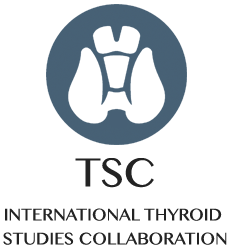An alternative to conducting large research studies is the compilation and analysis of existing data from cohort studies. Compiling as much data as possible in the TSC increases the number of observations, significantly increasing the statistical power and the meaning of the resulting outcome. With the collaboration of 29 separate international cohort studies, the TSC database now has data on over 148,000 participants. This raises the possibility of clarifying the risk of subclinical thyroid dysfunction. The TSC has already been published in high IF journal to clarify the cardiovascular and fracture risks associated with subclinical thyroid dysfunction → Publications.
The Thyroid Study Collaboration
Compiling Thyroid-Data
Subclinical Thyroid Dysfunction
Subclinical thyroid dysfunction is present in adults with abnormal thyroid-stimulating-hormone (TSH) and normal free thyroxine (fT4). Increased TSH levels with normal fT4 is defined as subclinical hypothyroidism, whereas a decreased TSH level with normal fT4 is determined as subclinical hyperthyroidism. Thyroid hormones (fT4, fT3) play critical roles in numerous physiological processes and their abnormalities can adversely affect different health issues.
Subclinical Hypothyroidism
A mildly underactive thyroid, a condition also known as subclinical hypothyroidism (SCH) affects around one in six people over the age of 65 and has been linked to various health problems, such as heart attacks and strokes, in later life. However, at this point in time knowledge is lacking on how to treat these patients best, because extensive research has never been done.
The obtained knowledge from data analysis of large data-sets such the TSC database may contribute to improve the health and well-being of older people with subclinical hypothyroidism, by clarifing uncertainities about how best to manage this common condition.
Subclinical Hyperthyroidism
Subclinical hyperthyroidism is defined by a low or undetectable serum thyroid-stimulating hormone level, with normal free thyroxine and total or free triiodothyronine levels. It can be caused by increased endogenous production of thyroid hormone. Subclinical hyperthyroidism is associated with an increased risk of atrial fibrillation and heart failure in older adults, increased cardiovascular and all-cause mortality, and decreased bone mineral density and increased bone fracture risk in postmenopausal women. However, the effectiveness of treatment in preventing these conditions is unclear.




